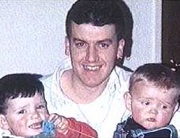
Blood samples on the clothing of Catholic murder victim Robert Hamill were not analysed, the inquiry into into his murder has heard.
The Catholic father-of-three died in hospital, having suffered brain damage, 12 days after being kicked unconscious by a loyalist mob in April 1997.
A public inquiry into collusion in the case is investigating why members of the PSNI sitting in a Land Rover at the scene looked on as the fatal attack was taking place.
A number of men were charged in connection with Mr Hamill’s death, but the charges were later dropped. The Catholic community in Portadown believe the PSNI investigation was deliberately subverted to protect the loyalist killers.
It emerged at the inquiry this week that blood splatters on Mr Hamill’s clothing had never been forensically tested.
Forensic scientist Lawrence Marshall told the inquiry he and his colleagues “have to be selective” because the government laboratory was “under a lot of pressure”.
Mr Marshall had identified a single “one penny-sized” spot of blood on Mr Hamill’s jeans as coming from Stacey Bridgett.
Bridgett was one of the five men who had murder charges against them dropped. It is not known whether other untested blood on the jeans also came from Bridgett.
The inquiry heard these jeans have since been declared “missing”.
Former RUC sergeant Donald Keys also told the inquiry that closed-circuit camera footage from the night of the murder had been destroyed as there had been “nothing pertinent” from any of the cameras.
Another police officer, Dereck Bradley of the CID, said he had “no recollection whatsoever” of a discussion with two of the victim’s sisters at Portadown police station about the footage.
The inquiry previously heard one of the sisters, Diane Hamill, testify that during a meeting one officer appeared “dumbstruck” when another admitted that footage showed the Land Rover in question.
The inquiry also heard that searches of the homes of two of the suspects were cursory and limited to only one room in each house.
Mr Keys also said he had banned the local SDLP minister, Brid Rodgers, from the police interview room as “the incident [the murder of Mr Hamill] was getting very political”.
Ms Rodgers, a Craigavon councillor at the time of the 1997 attack, told the inquiry that Catholic witnesses had been very reluctant to testify.
Just five of an estimated 12 Catholic people present when Robert Hamill was set upon during the sectarian attack have come forward to the inquiry.
“You have to understand the strength of feeling in Portadown about policing [at that time],” she said.
“They were seen as always taking the side of the loyal orders and unionists.
“I have a lot of respect for people and if people have very strong views about distrust it would not have been my place to say to these people: ‘Look, you’d better go along’ because in many ways I could see why they weren’t going along.”
Ms Rodgers said she did not think at the time that a lack of witness statements would hamper the inquiry.
“There must have been lots of other evidence,” she said.
“It comes down to the fact that the Catholic community had absolutely no faith in the police.”
The veteran politician, who retired from public life in 2005, told of “very strong rumours” among the nationalist community that police were involved in helping loyalist witnesses “get rid of evidence”.
Ms Rodgers said the allegation, which the inquiry heard was “one of the most shocking aspects of the whole inquiry”, was greeted in Portadown with the attitude “that’s just the way things are”.
![[Irish Republican News]](https://republican-news.org/graphics/title_gifs/rn.gif)
![[Irish Republican News]](https://republican-news.org/graphics/title_gifs/harp.gif)

